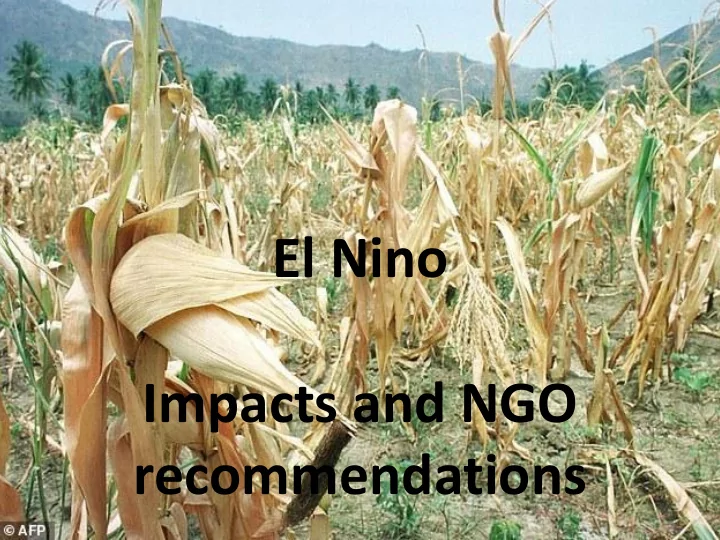

El Nino Impacts and NGO recommendations
NGO presentations • Debbie Hillier – Oxfam – Southern Africa and global • Bertrand Noiret – ACF - Ethiopia • Kostas Moschochoritis – Intersos – Somalia • Elisa Pozzi – Save the Children – global
Joanne Kambe, 33, stands next to an apua plant in front of her home in Danbagl, Papua New Guinea. It should be ready to harvest but after the droughts it just crumbles in her hand.
Margaret Thomas, 24, in her sweet potato field – it should be larger, fuller and producing four or five potatoes per plant. Margaret says each of these plants are likely to yield just one or two.
El Nino in Southern Africa • Second year of drought/poor harvests • High temps and least rainfall for 35 years • El Nino peak precisely for the rainy season • Rainy season should be Nov-Apr – but this year rains up to 2 months late, light, erratic • >50% of the population rely on rainfed ag • Disaster declared in Lesotho, Swaziland, Zimbabwe, SA provinces, and other countries asked for assistance
The impact • The paradox of a ‘green drought’ • Stunted crops, dead livestock, rivers dried • Prices rising alarmingly • High levels of chronic malnutrition • Food insecurity, water, health, animal health • WFP: 15.9m people are highly food insecure – and rising. • Zimbabwe, Malawi, Lesotho, Madagascar • South African harvest expected 26% down
Mrs Selina Shara Shumbanhete, aged 46, in her sorghum field, weeding and praying for rain. Normally her family would be eating watermelon, pumpkin and corn on the cob – but right now there is nothing. She thinks her children will get kwashiokor this year.
Prisca Chara. In a normal year, she would fill both her grain storage houses, but this year, she has very little. And what she does have, she keeps it in bags in the house where she sleeps – otherwise thieves will take it.
Esnat Pfaira Maedza, 67 years old, spending all day in her millet field, scaring birds away. “We are in pain with worry.”
Cereal availability crunch Perfect Storm • Poor harvest last year • National grain reserves low • Low stocks in the region; all countries affected • Logistical barriers – ports, rail, roads • De facto export bans and import restrictions • Prices rocketing – poor terms of trade • No employment opportunities
Inadequate response • Good vulnerability assessment system • But major data challenge – numbers, IPC, $, cereal availability, disaggregration • Low social protection coverage • Weak governance and national economies – Commodity prices, currency devaluations, low water = low power... • Weak regional leadership • Donors prioritising needs elsewhere
Southern Africa recommendations • Immediate action to increase food supply/reduce prices • Strengthen regional, national, local response capacity • Ensure adequate cereal supply until May 2017 – strategic management - private and public actors – transparent clear governance of grain reserves – seeds and inputs for winter-cropping • Invest now in ‘quick wins’ to support resilience, eg – Optimise water sources, small-scale irrigated community gardens, improve early warning information to farmers, cash for work schemes with DRR focus
The global response is working – but is not enough Saredo - inside her shelter with beans bought using money from Oxfam’s cash distribution in Bisle . Claire John: “Before I had this container I walk 4 -5 times a day for water. Now I can go once and it will last me 2-3 days. It is 20 minutes downhill to collect water. So this makes me very happy. I am very grateful to people who got this container for me .”
Sustainable solutions needed • Vivienne Barereba Tenambo in PNG learning new agricultural skills: improved irrigation options, mulching, pest & disease control, food preservation. • As Serah Thomas said: “We are born farmers! We just need support in marketing our produce! And of course new techniques!” Flor Marina Aquino, El Salvador after adopting new cultivation techniques and using organic fertiliser: “Now my garden is much more productive, and the growing season is longer than before. My tomatoes used to last only a month, but this time they lasted three months. I can even sell vegetables to my neighbours .”
Global recommendations - 1 Explicit recognition of need for increased urgency • Remaining uncertainty, high caseload for months • Early response is much cheaper Need increased funding • Donors increase financial and technical support for both the short and long term • Pledging conference required Need stronger leadership • National governments to provide political and technical leadership, and humanitarian space • International leadership – a Special Envoy? – to lead both short and long term response
Global recommendations – 2 • Invest long-term in resilience building – increase in scale and depth of social protection – agricultural reform – promotion of climate-smart livelihoods options – national resource and water management • Mainstream drought and emergency response into long-term development work. – Bring risk management into national dev strategies – Increase coordination: hum/dev/CC partners – Flexible, long term and early funding for drought – A switch from crisis to risk management
Recommend
More recommend